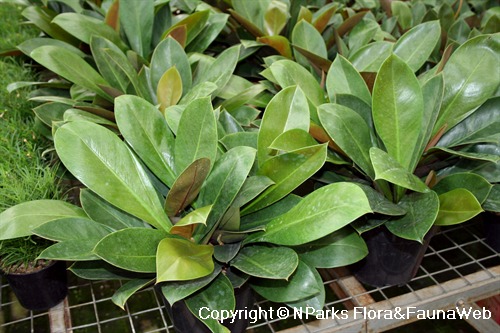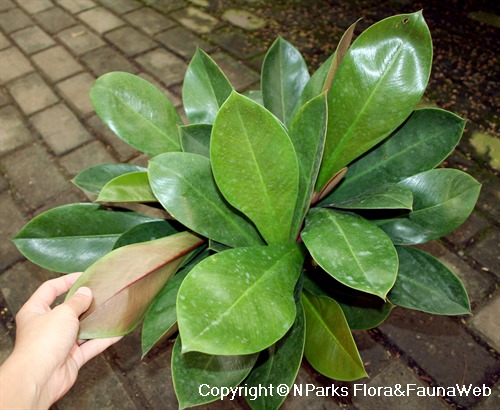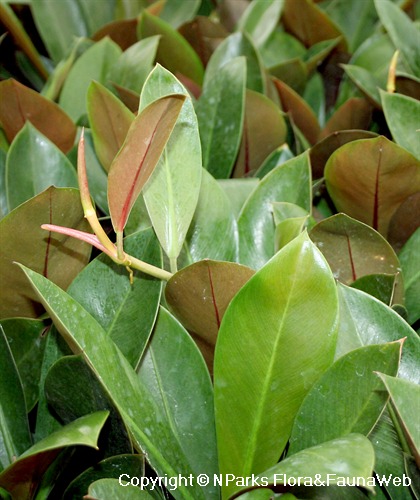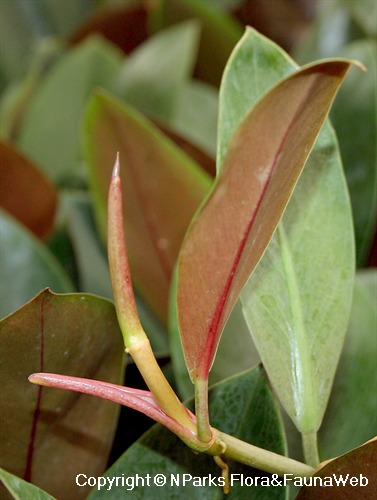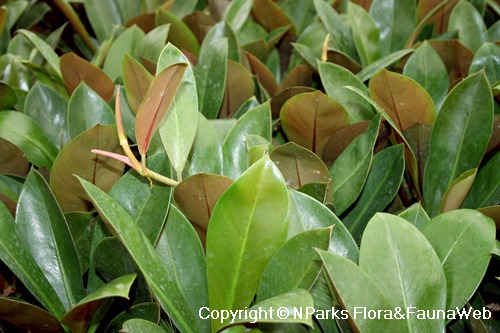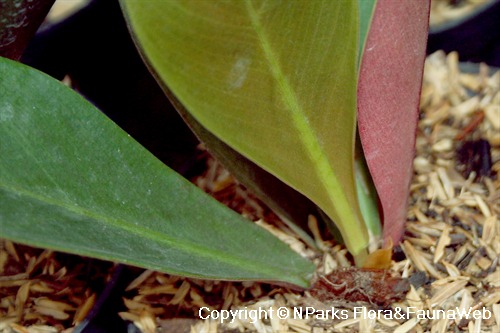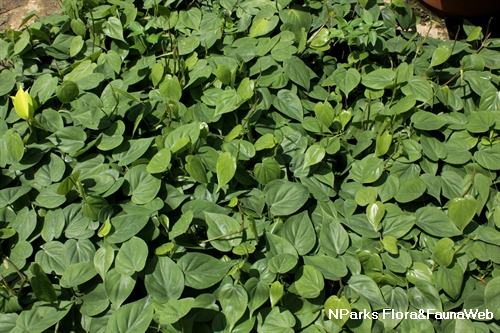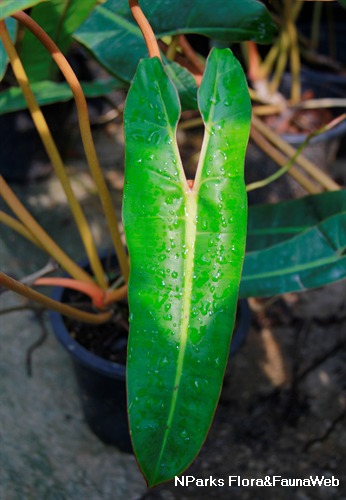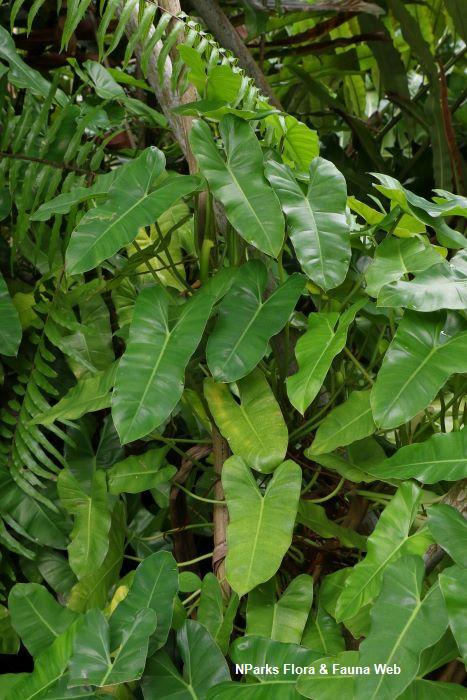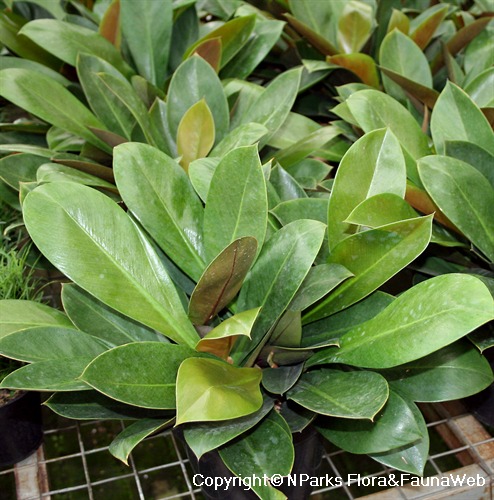
Back
Philodendron linnaei Kunth
| Family Name: | Araceae |
| Synonyms: | Philodendron linnaei var. linnaei, Philodendron decurrens, Philodendron nobile, Philodendron notabile |
Name
Classifications and Characteristics
| Plant Division | Angiosperms (Flowering Seed Plants) (Monocotyledon) |
|---|---|
| Plant Growth Form | Shrub, Climber, Epiphyte |
| Lifespan (in Singapore) | Perennial |
| Mode of Nutrition | Autotrophic |
Biogeography
| Native Distribution | Tropical South America |
|---|---|
| Native Habitat | Terrestrial (Primary Rainforest) |
| Preferred Climate Zone | Tropical |
Description and Ethnobotany
| Growth Form | Aroid. Herbaceous hemi-epiphytic climber, whose leaves overlap to form a tight rosette when plant is young, and a loose or partial rosette in mature specimens. Nest-like rosette structure enables plants to collect fallen debris as a means of moisture and nutrient storage. Typically up to 30cm height if grown in a container. |
|---|---|
| Foliage | Leaves obovate, with distinct apiculate tip, smooth and slightly leathery, green above and maroon-reddish below, with sunken midrib. Young leaves and runner-tips reddish. |
| Flowers | White, small and inconspicuous, produced in the form of spathe and spadix inforescences. Separate male and female flowers clustered on a columnar spadix, which is protected by a hooded red and white spathe (modified leaf). To avoid self-pollination, female flowers become receptive during the late afternoon or evening of the first day, while fertile and sterile male flowers are produced the next day. Sterile male flowers emit pheromones, which attract pollinator beetles. |
| Fruit | White berries, eaten by birds, monkeys and other rainforest fauna, which disperse the seeds via droppings. |
| Others - Plant Morphology | Runners: Occasionally produced, usually near apical meristem (terminal growing tip), either leafless or with isolated leaves at nodes. Stem internodes relatively long (up to 30cm or more), as compared to much shorter internodes (1.3-2.5cm) for rosette portions of plant. Once a suitable spot is located, runners take root and resume rosette form of growth. |
| Habitat | Attached to host trees in moist lowland rainforests, fairly widespread in northern Amazonian basin. |
| Similar | Closely resembles a slower-growing South American relative Philodendron insigne, which attains larger mature sizes and has a more pronounced rosette habit, but does not produce runners. Form and foliage also supeficially resemble those of the unrelated Asian forest understorey shrub Labisia pumila (Kacip Fatimah), whose leaves are narrower and also finely-serrated along the margins. |
| Cultivation | Provide moisture-retaining but very well-drained media like orchid potting mixes, peatmoss, sphagnum moss and perlite. Propagate by runners, stem cuttings or seeds. |
| Etymology | Genus epithet Philodendron' derived from Greek terms 'phileo' (to love) and 'dendron' (tree), meaning 'tree-loving' -- a reference to the tree-climbing habits of plants from this genus. Species epithet 'linnaei' named after Swedish botanist and zoologist Carl Linnaeus (1707-1778), best known as the father of modern taxonomy for having established the modern scheme of binomial nomenclature, which became universally accepted in the scientific world for the naming of organisms. |
Landscaping Features
| Desirable Plant Features | Ornamental Foliage, Ornamental Flowers |
|---|---|
| Landscape Uses | Suitable for Hanging Baskets, General, Vertical Greenery / Green Wall, Container Planting |
| Thematic Landscaping | Naturalistic Garden |
Fauna, Pollination and Dispersal
| Fauna Pollination Dispersal Associated Fauna | Bird-Attracting |
|---|---|
| Pollination Method(s) | Biotic (Fauna) (Insects (Ant, Beetle, Fly, Thrip, Wasp), Carrion Insects (Carrion Fly, Carrion Beetle)) |
Plant Care and Propagation
| Light Preference | Semi-Shade |
|---|---|
| Water Preference | Moderate Water |
| Plant Growth Rate | Slow |
| Rootzone Tolerance | Easy to Grow, Well-Drained Soils |
| Maintenance Requirements | Moderate |
| Propagation Method | Seed, Stem Cutting, Stolon / Runner |
Foliar
| Foliage Retention | Evergreen |
|---|---|
| Mature Foliage Colour(s) | Green, Red |
| Mature Foliage Texture(s) | Smooth, Glossy / Shiny, Leathery, Thick |
| Prominent Young Flush Colour(s) | Red |
| Foliar Type | Simple / Unifoliate |
| Foliar Arrangement Along Stem | Rosulate / Rosette |
| Foliar Shape(s) | Non-Palm Foliage (Obovate) |
| Foliar Venation | Parallel |
| Foliar Margin | Entire |
| Foliar Apex - Tip | Mucronate |
| Typical Foliar Area | Mesophyll ( 45cm2 - 182.25 cm2 ) |
Non - Foliar and Storage
| Stem Type & Modification | Herbaceous, Runner / Stolon |
|---|---|
| Root Type | Underground (Fibrous Root) |
Floral (Angiosperm)
| Flower & Plant Sexuality | Unisexual Flowers , Monoecious |
| Flower Colour(s) | Red, White |
|---|
| Inflorescence Type | Spathe & Spadix |
| Flowering Habit | Polycarpic |
| Inflorescence Size Remarks | Spadix changes from reddish to white. |
Fruit, Seed and Spore
| Mature Fruit Colour(s) | White |
|---|---|
| Fruit Classification | Simple Fruit |
| Fruit Type | Fleshy Fruit , Berry |
Image Repository
Others
| Master ID | 29434 |
|---|---|
| Species ID | 3743 |
| Flora Disclaimer | The information in this website has been compiled from reliable sources, such as reference works on medicinal plants. It is not a substitute for medical advice or treatment and NParks does not purport to provide any medical advice. Readers should always consult his/her physician before using or consuming a plant for medicinal purposes. |

